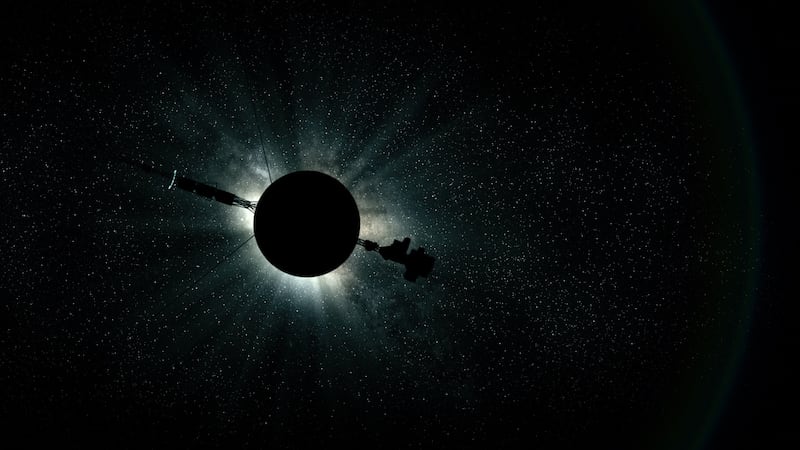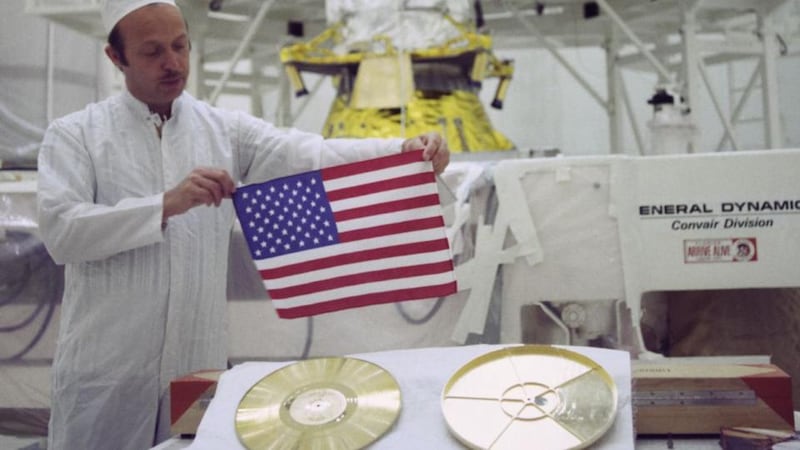In June 1977, four days after the death of Elvis, the first of two Voyager space probes were launched. More than 40 years later, Voyager 1 and 2 are still out there, travelling 62,140km every hour. In August 2012, 35 years after blast-off, Voyager 1 entered interstellar space, on a pathway towards the star AC +79 3888, located 17.6 light years from Earth. Between them, the identical craft have travelled 35 billion km.
The remarkable story behind this great expedition is chronicled in director Emer Reynolds's incredible new documentary, The Farthest. The film, which has already scooped multiple awards, has been a long time coming.
"It started – like all good stories, I suppose – in childhood," says Reynolds. "I was obsessed with space as a child. I spent part of my childhood growing up on a farm in Tipperary with really dark skies overhead. I could see the Milky Way. I loved stars and science and science fiction. Star Wars was the first film I ever saw. So I was always in love with the story of Voyager. I just thought it was so cute."
She laughs: “And romantic and powerful and lucky and poetic. I’m so glad I finally got the chance to make a film about it.”
How does one go about getting <a class="search" href='javascript:window.parent.actionEventData({$contentId:"7.1213540", $action:"view", $target:"work"})' polopoly:contentid="7.1213540" polopoly:searchtag="tag_organisation">Nasa</a> on board and putting the Voyager team back together for an Irish-produced documentary? Is there a hotline?
Ryonlds is a former student of theoretical physics at Trinity College Dublin (much like Room director Lenny Abrahamson). On campus, she fell in with the film society and future industry players such as Martin Duffy, Alan Gilsenan, and Martin Mahon. By the early 1990s, she was a key editor in that wave of Irish cinema, cutting Korea for Cathal Black, and Ailsa and I Went Down for Paddy Breathnach. She has worked steadily ever since, on such diverse titles as My Name is Emily, One Million Dubliners, and Channel 4's Shameless, winning back-to-back Iftas along the way.
Film vs space
"I can remember the very day it all started," she says. "I joined the film society in school at Manor House, Raheny. And the first film they showed was 12 Angry Men. I came home and had this huge debate-slash-row with my father about the story and prejudice and evidence. And I remember lying in bed that night thinking film can change the world. This is a really powerful medium that can unseat everything you've ever learned. I had wanted to be an astronaut up to that point. And suddenly, I forgot about space."

Now she has found a way to do both. In recent years, we've had to expand and renegotiate our idea of Irish film, in response to an industry that can now produce Oscar winners and global hits. The Farthest maps out even more daring terrain.
How does one go about getting Nasa on board and putting the Voyager team back together for an Irish-produced documentary? Is there a hotline?
"It's almost like that," says Reynolds. "My producers John Murray and Clare Stronge approached Nasa to get approval. Nasa want to check they're philosophically on board with the concept and the approach you're going to take. And then you start contacting all the people involved.
Some planned their families between the planets. They talk about their children - who are in their 30s now - saying: oh that's a Uranus baby, they were a Saturn baby"
“We tried to pitch the quality of film that were trying to make. To convey what it wasn’t going to be. We wanted to speak to a general audience, not just super science geeks like myself. And then Clare and I went out and met dozens of people. It was almost like they had been waiting 40 years. They had gone through the minutiae of the science. But no one had ever asked: what’s it like to be the person who did this and who is now watching it happen?”
Orbital speed
As Voyager scientist Carolyn Porco notes, at the moment of the launch: "So many things we take for granted now we knew nothing about. I had been staring at these planets through some of the best telescopes on Earth and all I could see was fuzzy blobs."
Thanks to mathematician Michael Minovitch, the team knew how to slingshot a probe into deep space. They knew that if a craft flew close to a planet orbiting the sun, it would steal some of the planet's orbital speed, and be accelerated away from the sun. And, for the first time in 126 years, their calculations showed that the planets were about to align in a way that that might enable their little bus-sized aluminium crafts to travel where no man-made object had been before.
“They knew it would keep going,” says Reynolds. “There was no reason it would ever stop. They just didn’t know if it would still be functioning, if it would still be sending signals back, if they would be able to engineer going past Neptune and the outlying planets. They just had this almost childlike belief that it would. But they were still pretty blown away by what this robust little craft achieved.”
Reynolds was almost as surprised by her participants and their genuine fondness for their spindly creations: “When I saw how attached they were to that little space craft, I knew I could reach a cinema audience too. I knew the scientific discoveries going in. But the personal stuff was like hearing secrets. Some planned their families between the planets. They talk about their children - who are in their 30s now - saying: oh that’s a Uranus baby, they were a Saturn baby. Those details were a real thrill for me.”
<em>The Farthest</em> can seem like a wonderful antidote to our polarised times. But there is, additionally, a Zen-like calm around the film's participants
Outer space licence
Interestingly, the Voyager crew have mixed feelings about the famous "golden record" that each craft carries. This is a gold-plated copper LP, packed with a needle, cartridge and instructions, and containing, in groove form, photos from Earth, a selection of natural sounds, plus music from a variety of cultures and eras. Tracks include Chuck Berry's Johnny B Goode, Glenn Gould performing from Bach's Well-Tempered Clavier, and a pygmy girl's initiation song from Zaire.
Carl Sagan, the project supervisor and astrophysicist, had wanted to include The Beatles' Here Comes the Sun, but EMI turned him down, saying "We don't licence for outer space." There are, additionally, spoken greetings in 55 languages, including such ancient dialects as Akkadian and Hittite. The Amoy message asks: "Friends of space, how are you all? Have you eaten yet? Come visit us if you have time." Nick Sagan, the Star Trek writer and son of Carl Sagan, recorded the English message as a child: "Hello from the children of planet Earth."
“I think one of the great things about Voyager is that it just naturally has these two pieces to it,” says Reynolds. “The heart and the mind. It combines extraordinary scientific discoveries and achievement with this romantic attempt to describe how we are as humans to an extra-terrestrial audience. This little craft built in the 1970s is knocking it out of the park in terms of science. But it also has this amazing golden record attached to the outside of the craft which is insane that is trying to communicate with aliens. It has everything we are as people.”

‘Family portrait’
The on-board camera on each Voyager was deactivated to save power 27 years ago, but not before it took the celebrated shot of our solar system from almost 6.5 billion kilometres out, a “family portrait” featuring Neptune, Uranus, Saturn, Jupiter, Venus, Earth and the Sun. Voyager 1 may leave the heliosphere before it runs out of power entirely in 2025. At that point, its primary function will be as a message in a bottle, a message electroplated with uranium-238, an isotope that will preserve its contents for billions of years after our “pale blue dot”, as Carl Sagan had it, is gone.
The Farthest can seem like a wonderful antidote to our polarised times. But there is, additionally, a Zen-like calm around the film's participants, an attitude that probably comes from being part of a cosmic journey into deepest space.
“I can see that in other people who do have an interest in the stars,” says Reynolds. “There’s a kind of profound restfulness in realising how insignificant we are. But not to each other. As a result, the scientists you meet in this field have an aura of acceptance about them. They know their role and place in this boundless universe. Their role is to be both insignificant and amazing.”
The Farthest is on general release
EMER REYNOLDS’S SCIENCE FICTION PICKS
Blade Runner (Ridley Scott, 1982)
When recently asked about the matter of Deckard's identity – human or replicant? – in Blade Runner and its incoming sequel, Blade Runner 2049, star Harrison Ford said, with characteristic Fordishness: "It doesn't matter what I think."
Under the Skin (Jonathan Glazer)
If it wasn't weird enough accepting that Scarlett Johansson does her shopping in Glasgow and is assisted by Northern Irish road racing legend Jeremy McWilliams, she's also a murderous alien who lures unsuspecting Scots into an ill-defined vortex. Scar-Jo's best movie.
Upstream Colour (Shane Carruth, 2013)
Parasitic larvae passes from human to pig to orchid in this marvellously dense parable of addiction. Confused? You will be. But in a good way.
Primer (Shane Carruth, 2004)
Two engineers accidentally discover time-travel and, in doing so, a movie structure that will richly reward note-taking. Untangling the timeline makes for hours of fun across multiple viewings.
Arrival (Denis Villeneuve, 2016)
Amy Adams brilliantly dramatises ideas about language and determinism in this wonderful alien invasion drama.
Aliens (James Cameron, 1986)
After floating in space for 57 years, Lieut Ripley’s (Sigourney Weaver) shuttle is found by a deep space salvage team. Can she survive the xenomorphs? Yep. Will you ever hear the term xenomorph again? Nope. Cue decades of canonical fan arguments.












